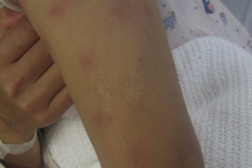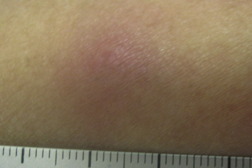Kikuchi-Fujimoto disease with cutaneous presentation in a patient with subacute cutaneous lupus erythematosus
Published Web Location
https://doi.org/10.5070/D37nz2c9r4Main Content
Kikuchi-Fujimoto disease with cutaneous presentation in a patient with subacute cutaneous lupus erythematosus
Julieta Ruiz Beguerie1,3 MD, Pablo Fernandez Penas1,3 MD PhD, Raghwa Sharma2,3 MD
Dermatology Online Journal 18 (9): 8
1. Department of Dermatology, Westmead Hospital, Westmead, New South Wales, Australia2. Department of Pathology
Westmead Hospital, Westmead, New South Wales, Australia
3. Westmead Medical School, The University of Sydney, Sydney, New South Wales, Australia
Abstract
We report the case of a 45-year-old female patient previously diagnosed with subacute cutaneous lupus erythematosus who presented with a one-week history of fever, tender erythematous nodules on her limbs, and palpable lymphadenopathy. Two incisional biopsies showed histiocytic infiltrates with abundant nuclear debris in the dermis and at the dermosubcutaneous junction with absence of neutrophils, characteristic of Kikuchi-Fujimoto disease (KFD). The dermatologic and dermopathologic details of KFD are very heterogeneous and yet poorly described. We have reviewed the literature regarding KFD cases reported with cutaneous involvement trying to assess the skin features of the KFD or histiocytic necrotizing lymphadenitis.
Introduction
Kikuchi-Fujimoto disease or histiocytic necrotizing lymphadenitis is an enigmatic benign and self-limited acute or subacute syndrome of unknown etiology that presents with localized lymphadenopathy and fever, evolving during a period of 3-6 weeks. Few cases have been reported with extra nodal involvement. The skin, mucosa and bone marrow are the most common affected sites in these individuals. Patients are more often females in their late 20s to early 40s, with a higher prevalence among Asians. KFD (with and without skin involvement) is frequently associated with systemic lupus erythematosus (SLE) [1]. Although there seems to be a strong link with SLE, the nature of this association remains elusive. KFD can precede, follow, or coincide with the diagnosis of SLE [2]. We report a case of a 45-year-old woman with previous diagnosis of subacute cutaneous lupus erythematosus (SCLE), who presented with fever, localized lymphadenopathy, and generalized erythematous nodules, confirmed to be KFD.
Case report
A 45-year-old woman presented with a one-week history of high fever (39°C) and generalized tender erythematous nodules on the skin, in February 2010. She did not describe similar episodes. In 2008, she was diagnosed with SCLE following UV light exposure and treatment with hydroxychloroquine 200 mg daily was started with good response. The diagnosis was based on skin lesions, skin biopsies, and 4 of the criteria for the classification as SLE. She was taking no other medication at the time of presentation. Her medical background was otherwise unremarkable. She did not smoke or consume alcohol and there was no history of recent infectious disease.
 |  |
| Figure 1 | Figure 2 |
|---|
On physical examination, multiple, generalized subcutaneous nodules were found on the skin, although lesions were more prominent on her limbs (Figures 1 and 2). Enlarged, palpable lymph nodes were found in the cervical area and left axillae.
Urine and blood cultures were negative and a chest X-ray was normal. Her blood test results showed increased C-reactive protein of 21 mg/dl (<0.3 mg/dl) and ESR of 77 mm Hg (<27 mm Hg). She had mild anemia with hemoglobin of 10.4 g/dL (12-16 g/dL) with no lymphopenia and no neutrophilia. SS-A and SS-B were positive and ANA 1:1000 and ds DNA were negative.
 |
| Figure 3 |
|---|
| Figure 3. H&E x40 |
A clinical differential diagnosis of subcutaneous lupus erythematosus, erythema nodosum, or Sweet syndrome was considered. Two biopsies from the cutaneous nodules on the arms were stained with Hematoxylin/Eosin, showing perivascular and some periadnexal lymphohistiocytic infiltrates in the superficial and deep dermis and histiocytic aggregates with prominent karyorrhexis in the dermis and at the dermosubcutaneous junction (Figure 3). Despite the large amount of nuclear debris, neutrophils were absent in the infiltrate. There was no granulomatous reaction, no fibrinoid vasculitis or paniculitis. Ziel Nielsen, Periodic acid-Schiff (PAS), and periodic acid-Methenamine stains were all negative for microorganisms. The immunofluorescence report performed with FITC-conjugated anti-IgG, IgA, IgM, C3, C1q, fibrinogen, and albumin did not find any significant immune deposits. Fine needle aspiration cytology of the left axillary lymph node showed histiocytic necrotizing lymphadenitis (without granulocytic infiltration) and necrosis of cortical and paracortical areas with an extensive infiltrate of lymphocytes, histiocytes, and immunoblasts.
Treatment was started with hydroxychloroquine 200 mg daily, prednisone 10 mg daily, and naproxen 500 mg twice daily. All symptoms including fever and erythematous nodules cleared spontaneously within 1 month, leaving a few hyperpigmented macules over the left forearm. No new lesions were seen after this episode.
Discussion
Kikuchi-Fujimoto disease was first described by Kikuchi and Fujimoto simultaneously, in 1972 in Japan [3, 4]. The etiology of this rare disease is still controversial. It has been suggested that apoptosis plays a key role in its pathogenesis, considering the histiocytes the ones enhancing this in KFD [5]. The initiating events and possible pathogens remain unknown. It has been reported that a viral or an autoimmune cause could play a role in KFD, but has not been convincingly demonstrated yet. In 2009, Gionanlis et al suggested the possible pathogenetic role of Epstein Barr virus (EBV), linking KFD with SLE. Other viruses have also being suggested throughout the years (Parvovirus 19, HHV8, HHV6, HTLV1, dengue virus) [6]. Several authors have described an association between KFD (involving the lymph nodes alone or with the skin) and autoimmune disorders, mainly SLE, mixed connective tissue disease, scleroderma, autoimmune hepatitis, and polymyositis.
In our patient, the diagnosis of SCLE was made 2 years prior to the evolution of KFD. Most reported cases with the association of KFD and lupus are with SLE and without skin manifestations of KFD. This possible association is important because KFD might be the initial diagnosis in patients who go on to develop SLE later on. Therefore, it is recommended that patients must be monitored long term for SLE. A lag time of 10 months to 3 years has been observed between the diagnosis of KFD and the subsequent onset of SLE [2].
Most patients diagnosed with KFD have no cutaneous findings. However, skin involvement has been reported in up to 30 percent of the patients in one study [7]. The skin lesions are extremely variable and non-specific in nature, which makes KFD more prone to be under diagnosed. Lesions can appear as maculopapular, morbiliform or rubella-like, urticarial, drug-eruption-like, erythematous plaques and oral ulcers. The eruption is distributed preferentially on the face, trunk, and upper extremities [5, 8]. Literature search has yielded only two other cases presenting with erythematous nodules and histologic confirmation of KFD [9, 10]. The diagnosis of KFD usually is based upon the clinical presentation and the lymph node histology, which shows a patchy necrotizing process affecting the paracortical areas of the lymph nodes. The most common findings in the histologic description of skin biopsies were dermal histiocytic infiltrate (lymphohistiocytic), epidermal change with an emphasis on necrotic keratinocytes, non-neutrophilic karryorrhectic debris, basal vacuolar change, and papillary dermal edema [8]. There seems to be a correlation between skin lesions and histological findings because non indurated lesions show non-specific dermatitis. This suggests that biopsies should be done from the most indurated lesions when there is suspicion of KFD.
Kikuchi-Fujimoto disease usually does not require treatment because it tends to spontaneously disappear in a matter of 4 weeks or less. However, some patients could benefit from a short course of prednisone to speed up resolution. Even though it has a benign course, some fatalities related directly to KFD have been reported in the literature such as pulmonary hemorrhage [11]. Recurrence of the disease seems to occur in no more than 3.3 percent [1]. Sumiyoshi and collaborators even indicated that the disease tends to have a more severe clinical course when the patients have skin involvement [12].
In conclusion, KFD is an unusual, self-limited, and under-diagnosed condition. In most cases it is a benign cause of fever, lymphadenopathy, and skin lesions. Even though skin involvement is rare, KDF should be in the differential diagnosis of erythematous nodules. Clinical suspicion and a thoughtful collaboration between dermatologists and pathologists are essential for accurate diagnosis and appropriate treatment and follow up. Long term follow-up of KFD patients for subsequent development of autoimmune diseases, especially SLE is suggested.
References
1. Baumgartner BJ, Helling ER. Kikuchi's disease: A case report and review of the literature. Ear, Nose & Throat J. 2002; 81:331-5. [PubMed]2. Dorfman RF, Berry GJ. Kikuchi's histiocytic necrotizing lymphadenitis: An analysis of 108 cases with emphasis on differential diagnosis. Semin Diagn Pathol. 1988; 5:329- 45. [PubMed]
3. Kikuchi M. Lymphadenitis showing focal reticulum cell hyperplasia with nuclear debris and phagocytosis. Nippon Ketsueki Gakkai Zasshi. 1972; 35: 379-80.
4. Fujimoto Y, Kozima Y, Yamaguchi K. Cervical subacute lymphadenitis: a new clinicopathologic entity. Naika. 1972; 20: 920-7.
5. Yasukawa K, Matsumura T, Sato-Matsumura K et al. Kikuchi's disease and the skin: case report and review of the literature. Br J Dermatol. 2001; 144: 885-9. [PubMed]
6. Gionanlis L, Katsounaros M, Bamihas G et al. Kikuchi-Fujimoto Disease and Systemic Lupus Erythematosus: The EBV Connection? Renal Failure. 2009; 31: 144-8. [PubMed]
7. Seno A, Torigoe R, Shimoe K et al. Kikuchi's disease (necrotizing lymphadenitis) with cutaneous involvement. J Am Acad Derm. 1994; 30: 504-6. [PubMed]
8. Atwater AR, Longley BJ, Aughenbaugh WD. Kikuchi's disease: case report and systematic review of cutaneous and histopathologic presentations. J Am Acad Dermatol. 2008; 59: 130-6. [PubMed]
9. Kuo TT. Cutaneous manifestation of Kikuchi's necrotizing lymphadenitis. Am J Surg Pathol. 1990; 14: 872-6. [PubMed]
10. Facchetti F, Marocolo D, Morassi ML et al. Cutaneous Kikuchi's disease. Am J Surg Pathol. 1991; 15: 1012-8. [PubMed]
11. Wong CY, Law T, Shum TT et al. Pulmonary haemorrhage in a patient with Kikuchi disease. Monaldi Arch Chest Dis. 2001; 56: 118-20. [PubMed]
12. Sushiyomi Y, Kikuchi M, Ohshima K et al. A case of histiocytic necrotizing lymphadenitis with bone marrow and skin involvement. Virchows Arch A Pathol Anat. 1992; 420: 275-9.[PubMed]
© 2012 Dermatology Online Journal

